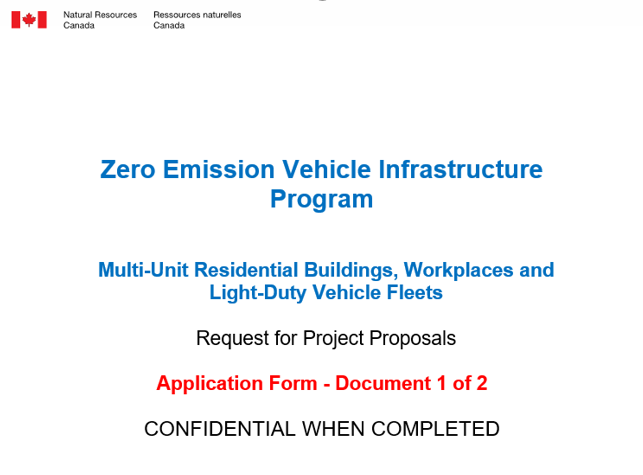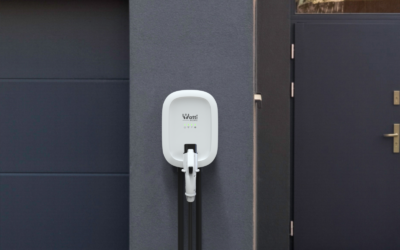With rebates and incentives, Canadians can get access to electric vehicles with over 400 km of range for under $40,000. By comparison, “Nova Scotia noted an average new internal combustion vehicle price of $37,025”, and with the new provincial rebate, EVs are more accessible to Canadians than ever before. One final hurdle to address, however, is the accessibility of charging stations for these EVs. Natural Resource Canada’s “Zero Emission Vehicle Infrastructure Program”, ZEVIP for short, aims to address this discrepancy.

Currently, there is a round of funding available (see details below) from NRCan targeting; multi-unit buildings, workplaces, on-street parking, public places and light-duty vehicle fleets.
 Source: Natural Resources Canada
Source: Natural Resources Canada
The ZEVIP initiative is, however, a competitive process and there are some key components to consider when putting together your application. Here are the top 4 must-knows for a successful ZEVIP application:
TIP 1: IDENTIFY THE SITES THAT ARE A TOP PRIORITY FOR YOUR EV CHARGING GOALS
Earlier in the blog post, we mentioned both federal and provincial incentives for EV drivers. Where in your property portfolio does it make the most sense to give users access to charging? Perhaps for a multi-unit building, tenants have already asked about EV chargers. Or maybe you have employees who are interested in purchasing an EV but are delaying due to the lack of charging available at work. In either case, offering EV charging is a great differentiator for tenant or employee attraction and retention.
Once a site has been chosen, one must carefully consider where in the building the chargers make the most sense. For example, in an underground parking scenario, a location that has the most accessibility to the electric room is a great place to start. With that being said, something to consider while taking on an EV charging project is future-proofing buildings to allow for mass EV charging demand. One could allocate electric room space to the infrastructure and run the appropriate pipe and wire for charging.
TIP 2: WHAT IS THE AVAILABLE INFRASTRUCTURE AT THE SITES?
This is an extremely important question to consider when looking to install EV chargers. A standard level 2 charger can draw between 32 and 50 A of current while in use. Ensuring your building has the available ampacity to support your desired number of chargers is a must. It is especially important because ZEVIP has stipulated a minimum of 20 chargers per applicant (not necessarily per site) to be eligible.
One important feature to think about is load sharing across chargers. Products such as Enel-X’s JuiceBox can allow multiple chargers (up to 4) to share a single 40 A circuit. This can save massive infrastructure costs in an EV charging project.
Another way to showcase an applicant’s attention to detail would be to engage local contractors for pricing on the execution of the project. In addition, communicating with local utilities (for large projects, > 50 kW) about a proponent’s intended plan can show an applicant’s readiness to pursue the project. Demonstrating that available electrical service has been considered is a key component of a successful ZEVIP application.
TIP 3: WHAT IS THE TIMELINE OF YOUR ZEVIP PROJECT?
NRCan is most interested in supporting projects that have a clear, defined goal from an applicant who demonstrates that they can get the job done. Part of this is having a well-defined timeline for the project. See some examples below:
| Activities | Principal Milestones | Initiation Date (dd/mm/yyyy) |
Completion Date (dd/mm/yyyy) |
| Request for ZEVIP Application | ZEVIP application received | ||
| Gathering necessary info for ZEVIP Application | Site list built. Number of chargers per site agreed to internally. Enlist local contractors to get quotes on material. 2021 Internal Capital Funding allocated. | ||
| Securing 50% of project costs | Sign NRCAN Contribution Agreement | ||
| Establish a Schedule with installers | Ensure that program timelines as well as internal goals for installation timeframe are met. | ||
| Obtain Required Permits for Level 2 Installation | Engage with utilities to obtain the necessary permits for installation at each site. This to be carried out by chosen installer and overseen by the applicant. | ||
| Installation of Charging Stations | Work undertaken by local installers to get chargers operational. For in ground parking, run wiring to electrical room. For above ground installations, trenching must take place and further inspections to verify the work. |
These are just a few examples of milestones to highlight in an application. Showcasing that one has carefully considered all the work that needs to be undertaken and setting target timelines is an important part of a successful ZEVIP application.
TIP 4: WHAT IS YOUR COMPANY’S RATIONALE FOR UNDERTAKING AN EV PROJECT?
One of NRCan’s ZEVIP application process goals is to identify projects that are in line with Canada’s commitment to reduce greenhouse gas emissions and continue working toward our Paris agreement targets. Thus, it makes sense that NRCan is interested in partnering with organizations that have similar goals and values when it comes to sustainability.
As one goes through the ZEVIP process, consideration must be given to a company’s ecological commitment. If any other sustainable, green initiatives have been taken on by your company, make sure to include as much information about it as possible. NRCan is most interested in projects that make charging accessible to the most Canadians for the most amount of time. Be ready to explain how the electric vehicle charging project with your company is going to further the government’s goals. Being ready to speak to how EV charging is in line with your company’s goals and values and how charging at your site will benefit most Canadians is a crucial component of a successful ZEVIP application.
SO, WHAT NOW?
NRCan’s ZEVIP initiative is a great way to build out a nationwide network of electric vehicle infrastructure to make Canada an easier place to go electric. Although the funding is available now, it is a limited supply and a competitive process. Thus, putting the most comprehensive application together is extremely important to ensure your company gets access to the funding it needs to provide charging to an ever-growing EV driving clientele.
If you have further questions about ZEVIP, or if you’d like to learn more about how Catalyst can assist you in the application process, get in touch with our Renewable Energy Specialist, Matt, for more information!



